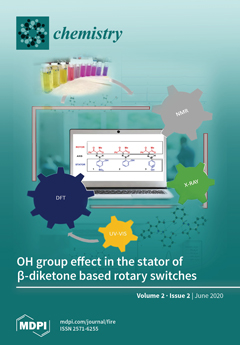The connection of a sterically constrained 3-methyl-pyrazine ring to a
N-methyl-benzimidazole unit to give the unsymmetrical α,α’-diimine ligand
L5 has been programmed for the design of pseudo-octahedral spin-crossover [Fe(
L5)
3]
2+ units, the transition temperature (
T1/2)
[...] Read more.
The connection of a sterically constrained 3-methyl-pyrazine ring to a
N-methyl-benzimidazole unit to give the unsymmetrical α,α’-diimine ligand
L5 has been programmed for the design of pseudo-octahedral spin-crossover [Fe(
L5)
3]
2+ units, the transition temperature (
T1/2) of which occurs in between those reported for related facial tris-didentate iron chromophores fitted with 3-methyl-pyridine-benzimidazole in a LaFe helicate (
T1/2 ~ 50 K) and with 5-methyl-pyrazine-benzimidazole
L2 ligands (
T1/2 ~350 K). A thorough crystallographic analysis of [Fe(
L5)
3](ClO
4)
2 (I), [Ni(
L5)
3](ClO
4)
2 (
II), [Ni(
L5)
3](BF
4)
2∙H
2O (
III), [Zn(
L5)
3](ClO
4)
2 (
IV), [Ni(
L5)
3](BF
4)
2∙1.75CH
3CN (
V), and [Zn(
L5)
3](BF
4)
2∙1.5CH
3CN (
VI) shows the selective formation of pure facial [M(
L5)
3]
2+ cations in the solvated crystals of the tetrafluoroborate salts and alternative meridional isomers in the perchlorate salts. Except for a slightly larger intra-strand interannular twist between the aromatic heterocycles in
L5, the metric parameters measured in [Zn(
L5)
3]
2+ are comparable to those reported for [Zn(
L2)
3]
2+, where
L2 is the related unconstrained ligand. This similitude is reinforced by comparable ligand-field strengths (∆
oct) and nephelauxetic effects (as measured by the Racah parameters
B and
C) extracted from the electronic absorption spectra recorded for [Ni(
L5)
3]
2+ and [Ni(
L2)
3]
2+. In this context, the strictly high-spin behavior observed for [Fe(
L5)
3]
2+ within the 5–300 K range contrasts with the close to room-temperature spin-crossover behavior of [Fe(
L2)
3]
2+ (
T1/2 = 349(5) K in acetonitrile). This can be unambiguously assigned to an intraligand arm wrestling match operating in bound
L5, which prevents the contraction of the coordination sphere required for accommodating low-spin Fe
II. Since the analogous 3-methyl-pyridine ring in [Fe(
L3)
3]
2+ derivatives are sometimes compatible with spin-crossover properties, the consequences of repulsive intra-strand methyl–methyl interactions are found to be amplified in [Fe(
L5)
3]
2+ because of the much lower basicity of the 3-methyl-pyrazine ring and the resulting weaker thermodynamic compensation. The decrease of the stability constants by five orders of magnitude observed in going from [M(
L2)
3]
2+ to [M(
L5)
3]
2+ (M = Ni
II and Zn
II) is diagnostic for the operation of this effect, which had been not foreseen by the authors.
Full article





